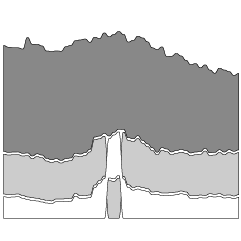Change in Common Household Types in the U.S.
In the 1970s, the most common household type in the U.S. was a married couple with kids. But over time, as people wait longer to get married and have fewer kids (if any), it’s grown more common to live alone or with non-family. The chart below shows the shifts between 1976 through 2021.

1976
1980
1990
2000
2010
2020
ONE-PERSON
MARRIED COUPLE
WITH CHILDREN
As people wait longer to have kids, households of married couples with children are less common.
It is most common to live alone these days.
28% of U.S.
Households
in 2021
37% of U.S.
Households
in 1976
MARRIED COUPLE
WITH NO CHILDREN
22%
MARRIED COUPLE
WITH NO CHILDREN
23%
MARRIED COUPLE
WITH CHILDREN
21%
ONE-PERSON
21%
It is also more common now to live with roommates and/or non-family.
COMPOSITE
11%
EXTENDED
7%
EXTENDED
9%
SINGLE MOTHER
7%
SINGLE MOTHER
6%
4%
COMPOSITE
SINGLE FATHER
2%
SINGLE FATHER
1%
1976
1980
1990
2000
2010
2020
SOURCE: CURRENT POPULATION SURVEY / IPUMS

1980
1990
2000
2010
2020
As people wait longer to have kids, households of married couples with children are less common.
It is most common to live alone these days.
ONE-PERSON
28% of U.S.
Households
in 2021
MARRIED COUPLE
W/O CHILDREN
22%
MARRIED COUPLE
W/ CHILDREN
21%
It is also more common now to live with roommates.
COMPOSITE
11%
EXTENDED
9%
SINGLE MOTHER 6%
SINGLE FATHER 2%
1980
1990
2000
2010
2020
SOURCE: CURRENT POPULATION SURVEY / IPUMS
While there are many household types, the ones here are based on definitions from the United Nations Statistics Division. They define four main types of households:
- One-person household
- Nuclear household — a household with a single family nucleus
- Extended household — a household with a single family nucleus with other people related to the nucleus
- Composite — A mix of nuclei or non-related people
They further breakdown the nuclear household to married with children, married without children, a father with children, and a mother with children.
Most of the change occurs among married couples with children, one-person, and composite households. The other types vary relatively little over the selected decades.
Become a member. Support an independent site. Make great charts.
See What You GetFlowingData is made possible by supporting members. Since 2007, I, Nathan Yau, a real person, have been analyzing and visualizing data to help more people understand and appreciate it in their everyday lives.
If you liked this or want to make similar data things, please consider supporting this small corner of the internet. You get unlimited access to visualization courses, tutorials, and extra resources. Thanks. — Nathan


